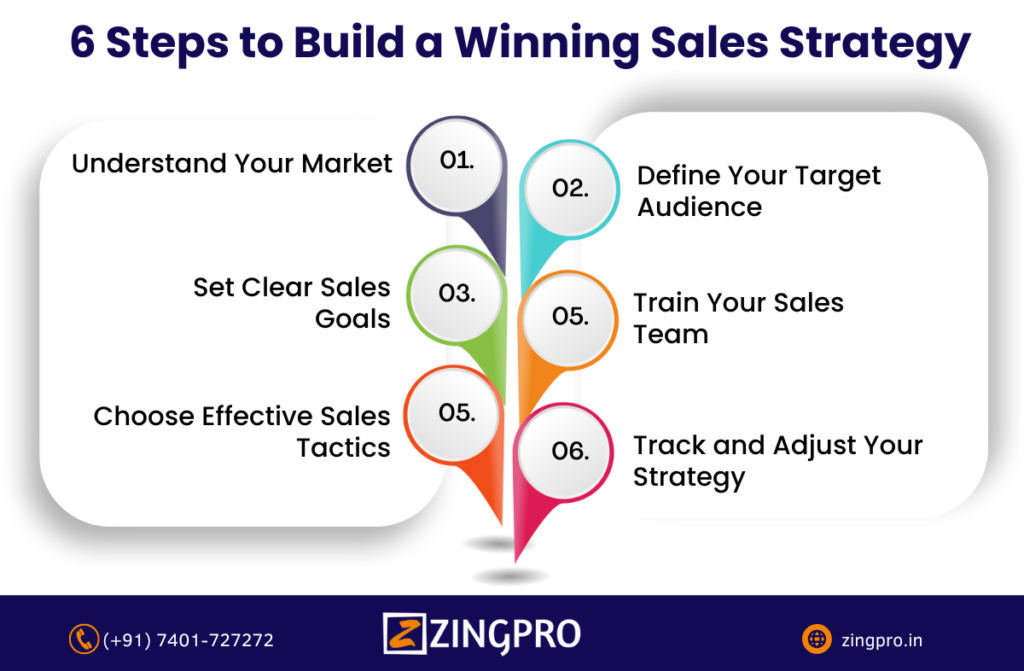Sales strategy development is a critical process for businesses looking to boost revenue and outperform competitors. A well-crafted strategy ensures your sales team understands how to approach the market, engage with prospects, and close deals effectively. Whether you’re creating a sales and marketing strategy or working on a sales team development plan, success requires focus and structure. In this guide, we break down key steps to developing a successful sales strategy that will empower your team and drive growth.
In today’s competitive business landscape, every company needs a solid sales strategy development process to reach its goals. Whether you’re a startup or an established business, having a strategic approach to sales is what separates high-performing teams from the rest. In this blog, we’ll explore how to develop an effective sales strategy, the steps involved, and how it can take your sales performance to the next level.

What is a Sales Strategy?
At its core, a sales strategy is a detailed plan that outlines how a business will sell its products or services to its target audience. It involves setting goals, understanding your audience, and deciding which sales tactics to use. Sales strategy development ensures that your sales efforts are aligned with your business goals, resulting in higher revenue, better customer relationships, and more efficient use of resources.
Why Do You Need a Sales Strategy?
Without a clear sales strategy development plan, your sales efforts can become disorganized, inconsistent, and inefficient. A sales strategy provides structure, guiding your team on how to attract new clients, engage with prospects, and close deals. Here’s why you need one:
- Consistency: It provides a clear process for your sales team to follow, ensuring that everyone is on the same page.
- Focus: Helps the team focus on high-potential leads and effective sales tactics.
- Measurement: With a strategy in place, it’s easier to track progress and identify areas for improvement.
- Scalability: As your company grows, a strategy allows for easy scaling of the sales process.
10 Popular Sales Strategy Types
When it comes to sales strategy development, businesses must tailor their approach based on their unique product offerings, target audiences, and market conditions. Here are ten popular sales strategies, each with its own distinct focus and benefits:
1. Inbound Sales
Inbound sales centers on attracting customers through valuable content and experiences tailored to their needs. This strategy emphasizes providing educational materials, engaging blog posts, and informative videos that draw potential buyers to your brand. By positioning your business as a trusted resource, you create a pull effect, encouraging leads to come to you.
Key Benefits:
- Builds trust and credibility.
- Reduces customer acquisition costs.
- Generates higher-quality leads.
2. Outbound Sales
Outbound sales involve actively reaching out to prospects through methods like cold calls, emails, and direct mail. This approach requires a proactive sales team to identify potential clients and initiate contact. While often viewed as more traditional, outbound sales can still be highly effective when targeting specific audiences with personalized messaging.
Key Benefits:
- Directly engages potential clients.
- Can generate immediate sales opportunities.
- Allows for a targeted approach to specific industries or demographics.
3. Consultative Sales
Consultative sales focus on understanding the customer’s needs and challenges. Sales representatives act as consultants, asking questions to uncover pain points and offering tailored solutions. This approach fosters deeper relationships and builds trust, as it emphasizes collaboration rather than mere transaction.
Key Benefits:
- Establishes strong customer relationships.
- Increases customer satisfaction through personalized solutions.
- Leads to higher conversion rates and repeat business.
4. Solution Selling
Solution selling is similar to consultative sales but emphasizes the presentation of comprehensive solutions rather than products alone. Sales professionals identify the client’s pain points and demonstrate how their product or service effectively addresses those challenges. This strategy is particularly effective in complex sales environments where customers require detailed explanations of how solutions will work for them.
Key Benefits:
- Differentiates your offering from competitors.
- Increases perceived value in the eyes of the customer.
- Can result in longer sales cycles but higher-value deals.
5. Value-Based Selling
Value-based selling focuses on highlighting the unique value and benefits your product or service provides. Rather than emphasizing features or price, this approach conveys how your offering improves the customer’s situation, ultimately leading to a more compelling sales narrative. This strategy is particularly effective in competitive markets.
Key Benefits:
- Aligns your product with the customer’s goals.
- Helps justify pricing based on perceived value.
- Strengthens customer loyalty and trust.
6. Social Selling
Social selling leverages social media platforms, particularly LinkedIn, to build relationships and engage with potential customers. Sales teams use social networks to share relevant content, participate in discussions, and connect with leads on a personal level. This strategy taps into the growing trend of networking and relationship building in a digital landscape.
Key Benefits:
- Expands your reach to a broader audience.
- Allows for targeted engagement based on interests.
- Facilitates relationship-building in a less formal context.
7. Account-Based Selling
Account-based selling (ABS) is a highly focused business strategy where sales and marketing teams work together to target specific high-value accounts. This strategy requires deep research and a personalized approach to engage decision-makers within those accounts, often involving tailored campaigns and communications.
Key Benefits:
- Increases efficiency by focusing on high-value prospects.
- Aligns sales and marketing efforts for a cohesive approach.
- Maximizes the potential for larger deals and longer-term contracts.
8. Transactional Sales
Transactional sales prioritize quick, volume-driven sales rather than building long-term relationships. This strategy is often used in retail and e-commerce environments where the focus is on getting customers to make immediate purchases. It relies heavily on streamlined processes and clear pricing structures.
Key Benefits:
- High efficiency in sales processes.
- Rapid revenue generation through increased transaction volume.
- Effective in markets with low customer acquisition costs.
9. Challenger Sales
The challenger sales model involves taking control of the sales conversation by educating customers about their business needs and providing tailored solutions. This approach requires sales professionals to challenge customers’ existing perceptions and encourage them to think differently about their needs and solutions.
Key Benefits:
- Positions your sales team as thought leaders.
- Encourages deeper discussions with clients.
- Can lead to more innovative solutions and partnerships.
10. Referral Sales
Referral sales leverage existing clients to gain new leads. This strategy encourages satisfied customers to refer your product or service to their network. Referral programs often include incentives for both the referrer and the new customer, creating a win-win situation.
Key Benefits:
- Increases trust and credibility through word-of-mouth.
- Often results in higher-quality leads.
- Can reduce customer acquisition costs significantly.
How to Build a Sales Strategy in 6 Steps
- Understand Your Market: Research your market, including competitors and customer needs.
- Define Your Target Audience: Create detailed buyer personas.
- Set Clear Sales Goals: Establish measurable objectives, such as revenue targets or customer acquisition numbers.
- Choose Sales Tactics: Decide which of the 10 sales strategies will work best for your business.
- Train Your Sales Team: Provide the tools and skills needed to execute the strategy.
- Track and Adjust: Monitor progress and make adjustments to the strategy as needed.
By following these steps, your sales strategy development process becomes clear and actionable.
Tools to Improve Your Sales Strategy
A great sales strategy doesn’t just rely on people – it also leverages tools to improve efficiency and effectiveness. Here are a few essential tools:
- CRM Software: Tools like Salesforce or HubSpot help you manage customer relationships and track leads.
- Sales Enablement Platforms: These tools provide your team with content, analytics, and insights to optimize their efforts.
- Automation Tools: Automating repetitive tasks like follow-up emails can save time and help you focus on closing deals.
Using the right tools can take your sales strategy development to the next level by streamlining operations and providing valuable insights.
Sales Team Development Plan
A sales strategy development plan is only as good as the team executing it. This is where a sales team development plan comes in. Developing a skilled, motivated sales team requires ongoing training, coaching, and development. Here are some steps to create an effective sales team development plan:
- Sales Training: Regular training sessions help your team stay up-to-date with the latest techniques and tools.
- Performance Tracking: Use key performance indicators (KPIs) to monitor the effectiveness of your team.
- Coaching and Feedback: Provide one-on-one coaching to help team members improve their skills.
- Incentive Programs: Motivate your team with performance-based incentives and rewards.
A strong sales team development plan ensures your team is equipped with the skills and motivation to execute your strategy successfully.
Creating a Sales and Marketing Strategy
Sales and marketing are two sides of the same coin, and a successful business integrates both seamlessly. Creating a sales and marketing strategy involves aligning the goals of both departments to drive lead generation, conversion, and customer retention. Key points to consider include:
- Collaboration: Ensure your sales and marketing teams are communicating regularly to share insights and strategies.
- Lead Qualification: Develop criteria for identifying qualified leads, so sales teams focus on high-potential opportunities.
- Content Marketing: Use marketing content to warm up leads before handing them over to sales.
By creating a sales and marketing strategy, you can bridge the gap between the two departments and improve overall business performance.
Sales Strategy Examples from Successful Sales Teams
Some of the world’s most successful companies have implemented excellent sales strategies. Let’s take a look at a couple of examples:
- HubSpot’s Inbound Sales Strategy: HubSpot is known for its effective inbound sales approach, using valuable content to attract leads and nurture them through the funnel.
- IBM’s Consultative Selling Approach: IBM uses consultative selling to understand customer pain points and offer tailored solutions.
These examples show how different approaches can be used in sales strategy development to achieve success.
Conclusion
In the fast-paced world of sales, having a solid sales strategy development plan is essential for consistent growth. Whether you’re building a sales team development plan or creating a sales and marketing strategy, the steps outlined here provide a strong foundation for success. By understanding your audience, setting clear goals, and continuously refining your approach, you can stay ahead of the competition and drive sustainable revenue.

